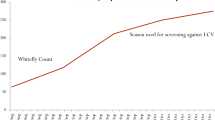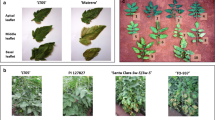Abstract
The two cultivated Luffa species can be severely infected by Tomato leaf curl New Delhi virus (ToLCNDV) with up to 100% yield loss. Here, 52 Luffa genotypes were screened for ToLCNDV resistance after natural field infection. Mean vulnerability index (VI) ranged from 0.00 to 75.33; genotypes IIHR-137 and IIHR-138 had no symptoms (VI 0), 16 genotypes were resistant (VI 0–25), 15 were moderately resistant (VI 26–50), and 19 were moderate to susceptible (VI > 50). Ten of the most resistant genotypes and five susceptible checks were then challenge-inoculated using whiteflies or sap in an insect-proof net house; only IIHR-137 [L. cylindrica (L.) Roem.] was symptomless (VI 0.00), and 3–5% of plants of IIHR-138 [L. cylindrica (L.) Roem.] and IIHR-Sel-1 [L. acutangula (L.) Roxb.] had only mild symptoms; genotype Arka Prasan was most susceptible (VI 80.96). Asymptomatic plants were confirmed as infected using polymerase chain reaction. Susceptible genotypes rapidly developed leaf curling, then a severe mosaic 10 days post-inoculation. The resistant inbred lines identified are good candidates for a breeding program for ToLCNDV-resistant cultivars.



Similar content being viewed by others

References
Ashwathappa KV, Venkataravanappa V, Reddy CNL, Krishna Reddy M (2020) Association of Tomato leaf curl New Delhi virus with mosaic and leaf curl disease of chrysanthemum and its whitefly cryptic species. Indian Phytopathol 73:533–542
Bos L (1982) Crop losses caused by viruses. Crop Prot 1:263–282
Cambell CL, Madden LV (1990) Introduction to plant epidemiology. Wiley, New York
Dhillon NPS, Sanguansil S, Singh SP, Masud MAT, Kumar P, Bharathi LK, Yetisir H, Huang R, Canh DX, McCreigh JD (2016) Gourds: bitter, bottle, wax, snake, sponge and ridge. In: Grumet R, Katzir N, Garcia-Mas J (eds) Genetics and genomics of Cucurbitaceae Plant genetics and genomics: crops and models, vol 20. Springer, Cham, pp 155–172
Islam S, Munshi AD, Mandal B, Kumar R, Behera TK (2010) Genetics of resistance in Luffa cylindrica Roem. against Tomato leaf curl New Delhi virus. Euphytica 174:83–89
Islam S, Munshi AD, Verma M, Arya L, Mandal B, Behera TK, Kumar R, Lal SK (2011) Screening of Luffa cylindrica Roem for resistance against Tomato leaf curl New Delhi virus, inheritance of resistance, and identification of SRAP markers linked to the single dominant resistance gene. J Horticult Sci Biotechnol 86:661–667
Ito T, Sharma P, Kittipakorn K, Ikegami M (2008) Complete nucleotide sequence of a new isolate of tomato leaf curl New Delhi virus infecting cucumber, bottle gourd and muskmelon in Thailand. Arch Virol 153:611–613
Karthik T, Ganesan P (2015) Characterization and analysis of ridge gourd (Luffa acutangula) fibres and its potential application in sound insulation. J Text Inst 107:1412–1425
Legg JP, Shirima R, Tajebe LS, Guastella D, Boniface S, Jeremiah S, Nsami E, Chikoti P, Rapisarda C (2014) Biology and management of Bemisia whitefly vectors of cassava virus pandemics in Africa. Pest Manag Sci 70:1446–1453
López C, Ferriol M, Picó MB (2015) Mechanical transmission of Tomato leaf curl New Delhi virus to cucurbit germplasm: selection of tolerance sources in Cucumis melo. Euphytica 204:679–691
Maruthi MN, Alam SN, Kader KA, Rekha A, Cork A, Colvin J (2005) Nucleotide sequencing, whitefly transmission, and screening tomato for resistance against two newly described begomoviruses in Bangladesh. Phytopathology 95:1472–1481
Mitra DK, Nariani TK (1965) A mosaic disease of tori (Luffa acutangula). Indian Phytopathol 18:233–236
Moriones E, Praveen S, Chakraborty S (2017) Tomato leaf curl New Delhi virus: an emerging virus complex threatening vegetable and fiber crops. Viruses 9:264
Padidam M, Beachy RN, Fauquet CM (1995) Tomato leaf curl geminivirus from India has a bipartite genome and coat protein is not essential for infectivity. J Gen Virol 76:25–35
Patil CV, Ramdas SV, Premchand U, Shankarappa KS (2017) Survey, symptomatology, transmission, host range and characterization of begomovirus associated with yellow mosaic disease of ridge gourd in southern India. Virusdisease 28:146–155
Pico B, Diez MJ, Nuez F (1998) Evaluation of whitefly-mediated inoculation techniques to screen Lycopersicon esculentum and wild relatives for resistance to Tomato yellow leaf curl virus. Euphytica 101:259–271
Prasanna HC, Sinha DP, Rai GK, Krishna R, Kashyap SP, Singh NK, Singh M, Malathi VG (2015) Pyramiding Ty-2 and Ty-3 genes for resistance to monopartite and bipartite tomato leaf curl viruses of India. Plant Pathol 64:256–264
Sáez C, Martínez C, Ferriol M, Manzano S, Velasco L, Jamilena M, López C, Picó B (2016) Resistance to Tomato leaf curl New Delhi virus in Cucurbita spp. Ann Appl Biol 169:91–105
Sangeetha B, Malathi VG, Alice D, Suganthy M, Renukadevi P (2018) A distinct seed-transmissible strain of Tomato leaf curl New Delhi virus infecting chayote in India. Virus Res 258:81–91
Silbernagel MJ, Jafari AM (1974) Temperature effects on curly top resistance in Phaseolus vulgaris. Phytopathology 64:825–827
Singh RP, Mohan J, Singh DP (2001) Symptomatology and distribution of ridge gourd mosaic virus. Agric Sci Digest 21:149–152
Sohrab SS, Mandal B, Pant RP, Varma A (2003) First reports of association of Tomato leaf curl New Delhi virus with yellow mosaic disease of Luffa cylindrica in India. Plant Dis 87:1148
Sohrab SS, Karim S, Varma A, Abuzenadah AM, Chaudhary AG, Damanhouri GA, Mandal B (2013) Characterization of Tomato leaf curl New Delhi virus infecting cucurbits: Evidence for sap transmission in a host specific manner. Afr J Biotechnol 12:5000–5009
Sohrab SS, Karim S, Varma A, Azhar EI, Abuzenadah AM, Mandal B (2014) Sap transmission of Tomato leaf curl New Delhi virus infecting sponge gourd in northern India. J Plant Interact 9:241–248
Swarnalatha P, Mamatha M, Manasa M, Singh RP, Krishnaeddy M (2013) Molecular identification of Ageratum enation virus (AEV) associated with leaf curl disease of tomato (Solanum lycopersicum) in India. Australas Plant Dis Notes 8:67–71
Swetha MP, Muthukumar SP (2016) Characterization of nutrients, amino acids, polyphenols and antioxidant activity of ridge gourd (Luffa acutangula) peel. J Food Sci Technol 53:3122–3128
Zaidi SS, Martin DP, Amin I, Farooq M, Mansoor S (2017) Tomato leaf curl New Delhi virus: a widespread bipartite begomovirus in the territory of monopartite begomoviruses. Mol Plant Pathol 18:901–911
Acknowledgements
The authors thank Dr A. D. Munshi for providing seeds of sponge gourd lines DSG-6 and DSG-7. The first author gratefully acknowledges Dr M. K. Reddy for his valuable guidance.
Author information
Authors and Affiliations
Corresponding author
Ethics declarations
Conflict of interest
The authors declare they have no conflict of interest. The manuscript was prepared in compliance with ethical standards.
Animal studies and human participants
This article does not contain any studies with human participants or animal.
Additional information
Publisher's Note
Springer Nature remains neutral with regard to jurisdictional claims in published maps and institutional affiliations.
Supplementary Information
Below is the link to the electronic supplementary material.
Rights and permissions
About this article
Cite this article
Kaur, M., Varalakshmi, B., Pitchaimuthu, M. et al. Screening Luffa germplasm and advanced breeding lines for resistance to Tomato leaf curl New Delhi virus. J Gen Plant Pathol 87, 287–294 (2021). https://doi.org/10.1007/s10327-021-01010-z
Received:
Accepted:
Published:
Issue Date:
DOI: https://doi.org/10.1007/s10327-021-01010-z



